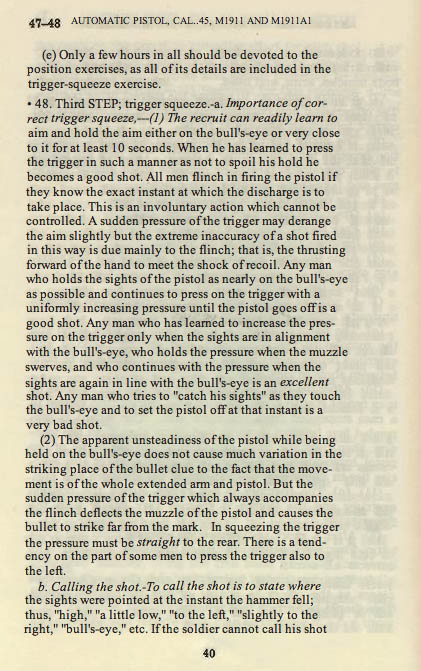AUTOMATIC PISTOL, CAL..45, M1911 AND M1911A1 (e) Only a few hours in all should be devoted to the position exercises, as all of its details are included in the trigger-squeeze exercise. • 48. Third STEP; trigger squeeze.-a. Importance of cor- rect trigger squeeze,—(1) The recruit can readily learn to aim and hold the aim either on the bull’s-eye or very close to it for at least 10 seconds. When he has learned to press the trigger in such a manner as not to spoil his hold he becomes a good shot. All men flinch in firing the pistol if they know the exact instant at which the discharge is to take place. This is an involuntary action which cannot be controlled. A sudden pressure of the trigger may derange the aim slightly but the extreme inaccuracy of a shot fired in this way is due mainly to the flinch; that is, the thrusting forward of the hand to meet the shock of recoil. Any man who holds the sights of the pistol as nearly on the bull’s-eye as possible and continues to press on the trigger with a uniformly increasing pressure until the pistol goes off is a good shot. Any man who has learned to increase the pres- sure on the trigger only when the sights are in alignment with the bull’s-eye, who holds the pressure when the muzzle swerves, and who continues with the pressure when the sights are again in line with the bull’s-eye is an excellent shot. Any man who tries to “catch his sights” as they touch the bull’s-eye and to set the pistol off at that instant is a very bad shot. (2) The apparent unsteadiness of the pistol while being held on the bull’s-eye does not cause much variation in the striking place of the bullet clue to the fact that the move- ment is of the whole extended arm and pistol. But the sudden pressure of the trigger which always accompanies the flinch deflects the muzzle of the pistol and causes the bullet to strike far from the mark. In squeezing the trigger the pressure must be straight to the rear. There is a tend- ency on the part of some men to press the trigger also to the left. b. Calling the shot.-To call the shot is to state where the sights were pointed at the instant the hammer fell; thus, “high,” “a little low,” “to the left,” “slightly to the right,” “bull’s-eye,” etc. If the soldier cannot call his shot


Comments, suggestions, contributions? Let me know